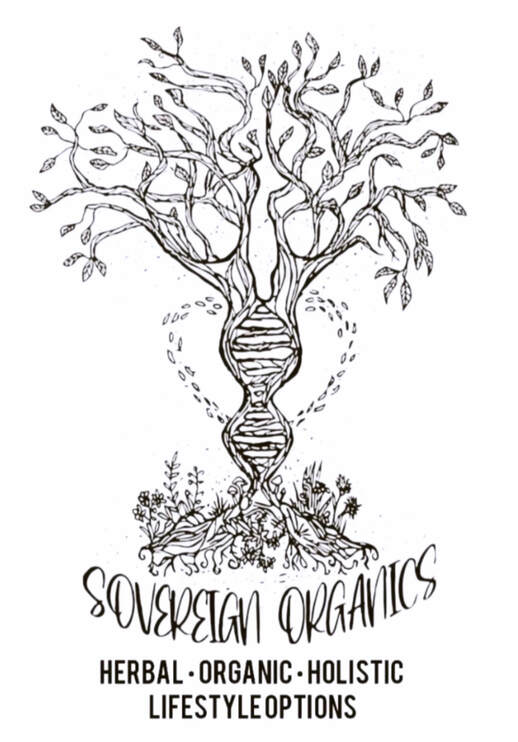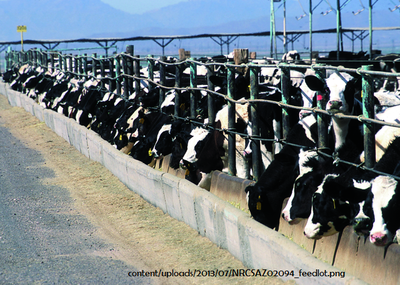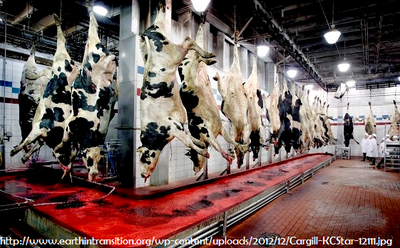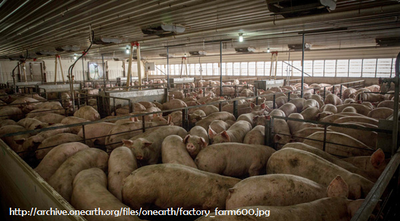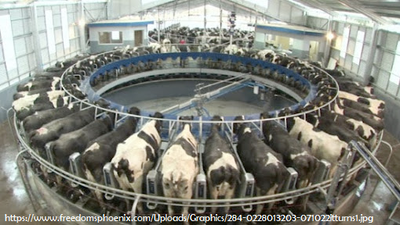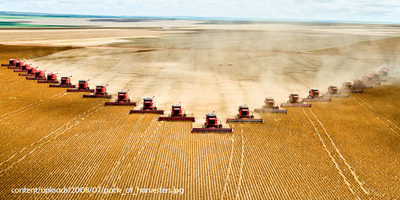Anthropogenic or that which is the result of human activity, is a term that can be used to help define certain pollutants which our species is responsible for emitting into the environment of planet Earth. To refer to a pollutant as being anthropogenic, one is saying that the source of the pollutant is a direct result of human activity.
Throughout the passing of generations, specifics and statistics may vary; however, since our divergence from a natural lifestyle to that of a chemical lifestyle, as a species, we have undoubtedly magnified the rate at which we emit toxic chemicals into our environment through unsustainable infrastructural and lifestyle practices.
Lets examine some of the largest contributors of toxic pollutants in our environment...
industrial agriculture |
ALSO KNOWN AS FACTORY FARMING, is the modern farming technique that endorses high-density occupation of farmlands, chemical dependence, genetic-modification, skewed life-spans of animals... among other tactics in order to achieve the goal of increasing yield (product per acre) while decreasing cost of production.
These methods include the use of toxic, carcinogenic chemicals including neonicotinoid pesticides and blatant unethical treatment of sentient beings.
Not only do these types of farming practices inflict immediate pain and suffering on the sentient beings enduring these unethical conditions, but we all suffer from the damage to the environment from having such high concentrations of pollutants coming from a single land area.
Throughout the passing of generations, specifics and statistics may vary; however, since our divergence from a natural lifestyle to that of a chemical lifestyle, as a species, we have undoubtedly magnified the rate at which we emit toxic chemicals into our environment through unsustainable infrastructural and lifestyle practices.
Lets examine some of the largest contributors of toxic pollutants in our environment...
industrial agriculture |
ALSO KNOWN AS FACTORY FARMING, is the modern farming technique that endorses high-density occupation of farmlands, chemical dependence, genetic-modification, skewed life-spans of animals... among other tactics in order to achieve the goal of increasing yield (product per acre) while decreasing cost of production.
These methods include the use of toxic, carcinogenic chemicals including neonicotinoid pesticides and blatant unethical treatment of sentient beings.
Not only do these types of farming practices inflict immediate pain and suffering on the sentient beings enduring these unethical conditions, but we all suffer from the damage to the environment from having such high concentrations of pollutants coming from a single land area.
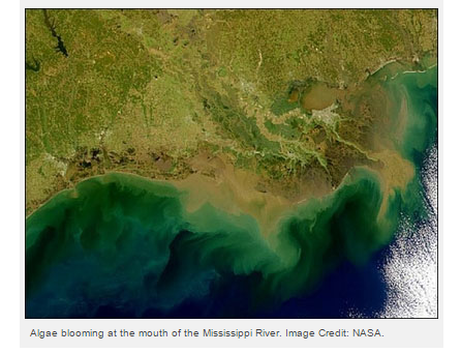
Industrial agriculture contributes to polluting our environment via point-source and non-point source means.
Non-point source pollution is often referred to as run-off. This occurs when water caused by rainfall or snow-melt and intensified by agricultural irrigation picks up and carries away natural and human-made pollutants along its flow. These pollutants are eventually deposited into watersheds through lakes, rivers, wetlands, coastal waters, and even our underground sources of drinking water.(1)
Such pollutants found in this flow of run-off water include cancer-causing pesticides and high-concentrations of the nutrients phosphorous, nitrogen & potassium which are used as
fertilizers. These nutrients eventually run-off into major watersheds and the sudden abundance of phosphorous & nitrogen in the water can lead to rapid increases in the density of certain types of phytoplankton.
In the abundance of nutrients, this phenomena, also known as an algal bloom, causes the phytoplankton that are native to the waters to grow out of control. Algae produces oxygen in the daytime via photosynthesis, but during the night hours they continue to undergo cellular respiration and can therefore deplete the water of available oxygen. In addition, when algal blooms die off, oxygen is used up further during bacterial decomposition of the dead algal cells. This can use up all or most of the oxygen in that water, leaving none for the other life forms; this often results in eutrophication and the mass death of many species.
Not only are the fertilizers used for fortifying plant-crops contributing to the pollutants in the run-off water, the demand for animal products contributes to depositing around 500 million tons of manure per year from 238,000 farms and ranches considered animal feeding operations in the US alone.(2) This animal feces not only contains excess nutrients, but can also carry bacteria and viruses.
In the 2000 National Water Quality Inventory, states reported that agricultural non-point source (NPS) pollution is the leading source of water quality impacts on surveyed rivers and lakes, the second largest source of impairments to wetlands, and a major contributor to contamination of surveyed estuaries and ground water (3)
Not only does this run-off affect the area it ends up in as its final destination, but it carries these toxins throughout all of the areas covered by its flow, depositing these harmful chemicals across a vast expanse of our environment.
We can also consider another type of pollution caused by industrial agricultural practices as being non-point source. This type of non-point source pollution is the pollution of your body that occurs when you ingest foods that contain the reminisce and residues of these toxic and carcinogenic pesticides.
According to a 2011 study from The University of California San Francisco called PESTICIDES MATTER: A primer for Reproductive Heath Physicians:
"Typical U.S. food consumption patterns can result in potentially high cumulative exposure to pesticides. Pesticide residues in the types and amounts of foods and beverages typically consumed by the U.S. population can lead over time to exposures that are high enough to increase the chance of children developing cancer and other chronic diseases.(19) It is estimated that 40 percent of U.S. children have enough cumulative exposure to pesticides to potentially impact their brains and nervous systems.(20)" (4)
The other type of pollution caused by the practices of industrial agriculture are defined as Point-Source Pollution. This refers to contaminants that enter a waterway from a single, identifiable source, such as a pipe or ditch. A way to remember what point source pollution is that you can point to where the pollution came from. (5)
In the case of industrial agriculture, a main means of point-source pollution occurs via the use of waste-lagoons.
"This July 2001 report from NRDC and the Clean Water Network documents how animal waste from factory farms threatens human health and our nation's rivers. Most factory farms store animal waste in open lagoons as large as several football fields. Lagoons routinely burst, sending millions of gallons of manure into waterways and spreading microbes that can cause gastroenteritis, fevers, kidney failure, and death. This report lists the track records of the largest polluters and recommends existing technology that is safer and more sustainable"(6)
Non-point source pollution is often referred to as run-off. This occurs when water caused by rainfall or snow-melt and intensified by agricultural irrigation picks up and carries away natural and human-made pollutants along its flow. These pollutants are eventually deposited into watersheds through lakes, rivers, wetlands, coastal waters, and even our underground sources of drinking water.(1)
Such pollutants found in this flow of run-off water include cancer-causing pesticides and high-concentrations of the nutrients phosphorous, nitrogen & potassium which are used as
fertilizers. These nutrients eventually run-off into major watersheds and the sudden abundance of phosphorous & nitrogen in the water can lead to rapid increases in the density of certain types of phytoplankton.
In the abundance of nutrients, this phenomena, also known as an algal bloom, causes the phytoplankton that are native to the waters to grow out of control. Algae produces oxygen in the daytime via photosynthesis, but during the night hours they continue to undergo cellular respiration and can therefore deplete the water of available oxygen. In addition, when algal blooms die off, oxygen is used up further during bacterial decomposition of the dead algal cells. This can use up all or most of the oxygen in that water, leaving none for the other life forms; this often results in eutrophication and the mass death of many species.
Not only are the fertilizers used for fortifying plant-crops contributing to the pollutants in the run-off water, the demand for animal products contributes to depositing around 500 million tons of manure per year from 238,000 farms and ranches considered animal feeding operations in the US alone.(2) This animal feces not only contains excess nutrients, but can also carry bacteria and viruses.
In the 2000 National Water Quality Inventory, states reported that agricultural non-point source (NPS) pollution is the leading source of water quality impacts on surveyed rivers and lakes, the second largest source of impairments to wetlands, and a major contributor to contamination of surveyed estuaries and ground water (3)
Not only does this run-off affect the area it ends up in as its final destination, but it carries these toxins throughout all of the areas covered by its flow, depositing these harmful chemicals across a vast expanse of our environment.
We can also consider another type of pollution caused by industrial agricultural practices as being non-point source. This type of non-point source pollution is the pollution of your body that occurs when you ingest foods that contain the reminisce and residues of these toxic and carcinogenic pesticides.
According to a 2011 study from The University of California San Francisco called PESTICIDES MATTER: A primer for Reproductive Heath Physicians:
"Typical U.S. food consumption patterns can result in potentially high cumulative exposure to pesticides. Pesticide residues in the types and amounts of foods and beverages typically consumed by the U.S. population can lead over time to exposures that are high enough to increase the chance of children developing cancer and other chronic diseases.(19) It is estimated that 40 percent of U.S. children have enough cumulative exposure to pesticides to potentially impact their brains and nervous systems.(20)" (4)
The other type of pollution caused by the practices of industrial agriculture are defined as Point-Source Pollution. This refers to contaminants that enter a waterway from a single, identifiable source, such as a pipe or ditch. A way to remember what point source pollution is that you can point to where the pollution came from. (5)
In the case of industrial agriculture, a main means of point-source pollution occurs via the use of waste-lagoons.
"This July 2001 report from NRDC and the Clean Water Network documents how animal waste from factory farms threatens human health and our nation's rivers. Most factory farms store animal waste in open lagoons as large as several football fields. Lagoons routinely burst, sending millions of gallons of manure into waterways and spreading microbes that can cause gastroenteritis, fevers, kidney failure, and death. This report lists the track records of the largest polluters and recommends existing technology that is safer and more sustainable"(6)
Another direct pollutant caused by the high density occupation of industrial agriculture land is the high concentrations of methane and other green house gases [GHG] emitted into our atmosphere. Because there is such a large number of animals undergoing cellular respiration, industrial agriculture farms contribute to a large portion of the green house gases human lifestyles pollute the atmosphere with. Though "greenhouse gases" are naturally occurring compounds, the rate at we we emit them as a species, which is not limited to agriculture, is blatantly unnatural and unlike any other generation.
According to J. Takahashi (graduate School of Animal Science, Obihiro University of Agriculture and Veterinary Medicine Obihiro, Japan):
"The mitigation of anthropogenic four GHG carbon dioxide (CO2 ), methane (CH4 ), nitrous oxide (N2 O) and sulphur hexafluoride (SF6 ) and two groups of GHG, hydrofluorocarbons (HFCs) and perfluorocarbons (PFCs) have been established as legally binding commitments in The Kyoto Protocol (IPCC, 1996). Important GHG attributed to animal agriculture are CH4 and N2 O. Rumen fermentation of ruminant livestock and anaerobic fermentation of agricultural organic waste including animal manures are major contributors of CH4 emission as anthropogenic sources (Moss, 1993)" (7)
Furthermore, industrial agriculture practices greatly degrade the health of the soil especially because of mono-cropping practices and imbalanced fertilization techniques.
The most vile pollutant caused by industrial agriculture... the pain, suffering and torture of sentient-beings. They are crammed in tight spaces, pumped with drugs, and subject to unethical practices such as being boiled alive, shred alive, raped, having their babies taken from them, thrown, tails ripped off...
This is an unfortunate reality, and most of us grew up unconsciously supporting all of the above with our lifestyle; however, as soon as you know better, you have the chance to start to do better. With a exponentially growing population and a system with a standard that does not respect the integrity of our biosphere, it is the ethical and responsible choice of the individual to maintain a plant-based, organic, homegrown lifestyle.
This includes diet, but furthermore health and beauty treatments, clothing, home crafts... throughout everything we do, we should ensure we are not destroying the planet, our bodies or contributing to cruelty.
For help finding organic markets in your area, you can google "natural food market" "organic food market" or type "organic food" into the navigation app on your phone.
organic market locator
For help finding sustainable brands/products CHECK OUT:
the VEGAN BEAUTY REVIEW
@THE_BOYCOTT_MOVEMENT
To promote a more sustainable lifestyle, we should begin again to grow our own vegetation & diverse, local flower species at home. We should also have a variety of plants in our home, to clarify the air and promote a peaceful living space. We should reflect in love and appreciation of our natural world each day, taking none for granted.
Choosing a vegan lifestyle is an ethical decision in these unique and perpetually arriving moments (especially) if you go get your food at a supermarket. Buy organic and local as much as possible, research about local organic farms/farmers markets in your area give them a call or visit ♡
SOURCES
(1) http://water.epa.gov/polwaste/nps/index.cfm
(2) http://water.epa.gov/polwaste/nps/agriculture_facts.cfm
(3) http://water.epa.gov/polwaste/nps/agriculture_facts.cfm
(4) http://prhe.ucsf.edu/prhe/pdfs/pesticidesmatter_whitepaper.pdf
(5)http://www.ribblelife.org/pollution
(6) http://www.nrdc.org/water/pollution/cesspools/cessinx.asp
(7)J. Takahashi. Prophylactic Modulation of Methane and Nitrous Oxide Emitted from Ruminants Livestock for Sustainable Animal Agriculture. Media Peternakan, December 2014, 37(3):206-214
TO COME, PART 2: FOSSIL FUELS
According to J. Takahashi (graduate School of Animal Science, Obihiro University of Agriculture and Veterinary Medicine Obihiro, Japan):
"The mitigation of anthropogenic four GHG carbon dioxide (CO2 ), methane (CH4 ), nitrous oxide (N2 O) and sulphur hexafluoride (SF6 ) and two groups of GHG, hydrofluorocarbons (HFCs) and perfluorocarbons (PFCs) have been established as legally binding commitments in The Kyoto Protocol (IPCC, 1996). Important GHG attributed to animal agriculture are CH4 and N2 O. Rumen fermentation of ruminant livestock and anaerobic fermentation of agricultural organic waste including animal manures are major contributors of CH4 emission as anthropogenic sources (Moss, 1993)" (7)
Furthermore, industrial agriculture practices greatly degrade the health of the soil especially because of mono-cropping practices and imbalanced fertilization techniques.
The most vile pollutant caused by industrial agriculture... the pain, suffering and torture of sentient-beings. They are crammed in tight spaces, pumped with drugs, and subject to unethical practices such as being boiled alive, shred alive, raped, having their babies taken from them, thrown, tails ripped off...
This is an unfortunate reality, and most of us grew up unconsciously supporting all of the above with our lifestyle; however, as soon as you know better, you have the chance to start to do better. With a exponentially growing population and a system with a standard that does not respect the integrity of our biosphere, it is the ethical and responsible choice of the individual to maintain a plant-based, organic, homegrown lifestyle.
This includes diet, but furthermore health and beauty treatments, clothing, home crafts... throughout everything we do, we should ensure we are not destroying the planet, our bodies or contributing to cruelty.
For help finding organic markets in your area, you can google "natural food market" "organic food market" or type "organic food" into the navigation app on your phone.
organic market locator
For help finding sustainable brands/products CHECK OUT:
the VEGAN BEAUTY REVIEW
@THE_BOYCOTT_MOVEMENT
To promote a more sustainable lifestyle, we should begin again to grow our own vegetation & diverse, local flower species at home. We should also have a variety of plants in our home, to clarify the air and promote a peaceful living space. We should reflect in love and appreciation of our natural world each day, taking none for granted.
Choosing a vegan lifestyle is an ethical decision in these unique and perpetually arriving moments (especially) if you go get your food at a supermarket. Buy organic and local as much as possible, research about local organic farms/farmers markets in your area give them a call or visit ♡
SOURCES
(1) http://water.epa.gov/polwaste/nps/index.cfm
(2) http://water.epa.gov/polwaste/nps/agriculture_facts.cfm
(3) http://water.epa.gov/polwaste/nps/agriculture_facts.cfm
(4) http://prhe.ucsf.edu/prhe/pdfs/pesticidesmatter_whitepaper.pdf
(5)http://www.ribblelife.org/pollution
(6) http://www.nrdc.org/water/pollution/cesspools/cessinx.asp
(7)J. Takahashi. Prophylactic Modulation of Methane and Nitrous Oxide Emitted from Ruminants Livestock for Sustainable Animal Agriculture. Media Peternakan, December 2014, 37(3):206-214
TO COME, PART 2: FOSSIL FUELS
